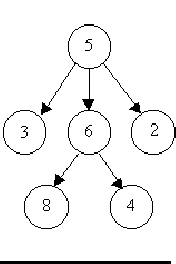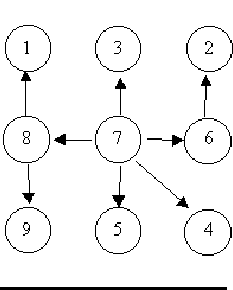HDU 1325(并查集)
Is It A Tree?
Time Limit: 2000/1000 MS (Java/Others) Memory Limit: 65536/32768 K (Java/Others)
Total Submission(s): 23312 Accepted Submission(s): 5338
Problem Description
A
tree is a well-known data structure that is either empty (null, void,
nothing) or is a set of one or more nodes connected by directed edges
between nodes satisfying the following properties.
There is exactly one node, called the root, to which no directed edges point.
Every node except the root has exactly one edge pointing to it.
There is a unique sequence of directed edges from the root to each node.
For example, consider the illustrations below, in which nodes are represented by circles and edges are represented by lines with arrowheads. The first two of these are trees, but the last is not.



In this problem you will be given several descriptions of collections of nodes connected by directed edges. For each of these you are to determine if the collection satisfies the definition of a tree or not.
There is exactly one node, called the root, to which no directed edges point.
Every node except the root has exactly one edge pointing to it.
There is a unique sequence of directed edges from the root to each node.
For example, consider the illustrations below, in which nodes are represented by circles and edges are represented by lines with arrowheads. The first two of these are trees, but the last is not.



In this problem you will be given several descriptions of collections of nodes connected by directed edges. For each of these you are to determine if the collection satisfies the definition of a tree or not.
Input
The
input will consist of a sequence of descriptions (test cases) followed
by a pair of negative integers. Each test case will consist of a
sequence of edge descriptions followed by a pair of zeroes Each edge
description will consist of a pair of integers; the first integer
identifies the node from which the edge begins, and the second integer
identifies the node to which the edge is directed. Node numbers will
always be greater than zero.
Output
For
each test case display the line ``Case k is a tree." or the line ``Case
k is not a tree.", where k corresponds to the test case number (they
are sequentially numbered starting with 1).
Sample Input
6 8 5 3 5 2 6 4
5 6 0 0
8 1 7 3 6 2 8 9 7 5
7 4 7 8 7 6 0 0
3 8 6 8 6 4
5 3 5 6 5 2 0 0
-1 -1
Sample Output
Case 1 is a tree.
Case 2 is a tree.
Case 3 is not a tree.
Source
Recommend
/*
HDU 1272的升级版,建议先做1272.
有向图,判断是不是树。
注意点:
1 2 2 1 0 0 No
1 2 1 2 0 0 No
1 2 3 4 0 0 No
0 0 Yes
ru[i]==0的个数要等于1.
*/
#include<map> #include<cstdio> #include<cstring> #include<algorithm> using namespace std; const int maxn = 1e5 + 15; int ru[maxn], a[maxn]; int main () { int ic = 0; int u, v; bool fg = true; while(fg) { memset(ru, 0, sizeof(ru)); bool ans = true; map<int, int> mp; int nu = 0; while(true) { scanf("%d%d", &u, &v); if(u == 0 && v == 0) { if(ans) { int t = 0; for(int i = 1; i <= nu; i++) { if(ru[a[i]] <= 1) { if(ru[a[i]] == 0) { t++; if(t > 1) { ans = false; break; } } } else { ans = false; break; } } } if(ans) printf("Case %d is a tree.\n", ++ic); else printf("Case %d is not a tree.\n", ++ic); break; } else if(u < 0 && v < 0) { fg = false; break; } if(!mp.count(u)) { a[++nu] = u; mp[u] = 1; } if(!mp.count(v)) { a[++nu] = v; mp[v] = 1; } if(ans) { ru[v]++; int t = u * 10000 + v; if(mp.count(t)) ans = false; else mp[t] = 1; t = u + v * 10000; if(mp.count(t)) ans = false; else mp[t] = 1; } } } return 0; }
想的太多,做的太少。



